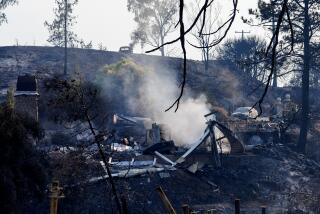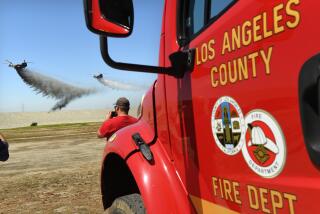Garcetti replaces LAFD Chief Cummings after 911 disclosures
Los Angeles Mayor Eric Garcetti’s decision to replace his fire chief after a tumultuous 18 months for the emergency rescue agency underscores one of the biggest challenges facing his administration: Rebooting the city’s aging technology to improve the delivery of vital services.
Chief Brian Cummings, who announced his retirement Thursday, never fully recovered from his management team’s admission in March of last year that highly touted 911 response times were inaccurate, making it appear that rescuers arrived faster than they actually did.
Subsequent Times’ investigations documented widespread delays in processing calls for help, routine failures to summon the closest medical rescuers from nearby jurisdictions and large disparities in getting rescuers to life-threatening emergencies in different areas of the city.
The fallout fueled a conflict between the chief and union officials over staffing adjustments and intensified City Hall’s demands for an overhaul of the complex — and largely outdated — patchwork of computer systems the LAFD relies on to handle 911 calls and manage hundreds of medical and accident rescues every day.
The city has launched a number of ambitious, expensive upgrades, including installation of GPS devices on rescue vehicles, the replacement of a breakdown-prone dispatching system and fixes to the alarm system that quickly alerts rescuers at the department’s 106 fire stations. A new number-crunching unit, modeled on a highly touted LAPD team that helps commanders quickly adjust resources as needed, also has been promised.
But concerns about the pace of progress and capability of the department’s current leadership to deliver improvements have been a recurring refrain among elected officials.
“I’ve not seen enough movement” at the Fire Department, Garcetti told reporters Thursday. “For a long time, we haven’t been able to implement technological change that we need quickly enough.”
In June, Cummings told The Times that he hoped to remain chief until at least 2018. He declined to answer questions about his departure at a charity-related news conference Thursday, but thanked rank-and-file firefighters in a written statement. He said he would continue until Feb. 1, when he plans to retire.
Garcetti broke with a tradition of choosing chiefs from within the active-duty, top ranks of the LAFD by naming James Featherstone, head of the city’s Emergency Management Department, as Cummings’ interim replacement.
Featherstone, who will move to the LAFD next month and is not expected to be a candidate for a permanent appointment, served 20 years in the Fire Department, reaching the rank of captain before leaving in 2007.
Firefighters who have worked with Featherstone said his experience in the field and leadership of the Emergency Management Department may serve him well managing a period of transition at the fire agency.
“He’s what we need to fix this ailing department.” said firefighter Steve Tufts, a 36-year department veteran.
For Garcetti, replacing Cummings marked his highest-profile management change since taking office July 1. Garcetti has required all department heads to reapply for their jobs and lay out plans to achieve key goals, including the use of new technologies to make the city run more efficiently.
So far, he has told at least seven top managers that they will get to stay, including Gina Marie Lindsey, who runs Los Angeles World Airports, and Michael LoGrande at the Department of City Planning.
Garcetti has said that of roughly three dozen agency chiefs, he expects to replace about 12. Among those leaving is Geraldine Knatz, the executive director of the Port of Los Angeles, one of the world’s busiest harbors.
Cummings, a second-generation firefighter with more than 30 years in the LAFD, was appointed chief by then-Mayor Antonio Villaraigosa in 2011 and earned nearly $300,000 last year.
As an assistant chief, Cummings promoted a controversial plan to trim LAFD spending during the economic downturn using a PowerPoint presentation built on detailed department data.
The proposal, which Garcetti supported as City Council president, initially boosted Cummings’ stature at City Hall, despite opposition from the city firefighters’ union. Villaraigosa praised Cummings as the “visionary architect” of the new staffing plan when he named him chief.
But Cummings’ stature plummeted after last year’s admission that published response times were faulty. A later report by a panel of experts concluded that those charged with managing LAFD statistics were poorly qualified and all of the agency’s earlier analyses “should not be relied upon.”
In subsequent months, Cummings was second-guessed in clashes with the City Council, fire commissioners, employee groups and the leading candidates for mayor, including Garcetti, who said he lacked confidence in the chief’s management and questioned a series of administrative decisions.
Cummings’ replacement will need to grapple with a $14-million shortfall in the department’s half-billion-dollar annual budget caused partly by increased ambulance services approved by the council, City Administrative Officer Miguel Santana said.
In the coming months, the department is also expected to wrestle with the sensitive issue of bringing lower-paid civilian dispatchers into the department’s 911 call center, which has historically been staffed by firefighters.
Councilman Bernard C. Parks said he was disappointed by Cummings’ departure, saying that the chief made major strides in addressing disciplinary issues at the department that had led to expensive lawsuits. In one case, multiple firefighters sued after an incident in which a member of the force was knowingly fed dog food at a station.
“He addressed those [disciplinary] issues very quickly,” said Parks, a former police chief. “And we have not seen that kind of horseplay at the stations.”
Westside Councilman Mike Bonin, who has complained that LAFD brass resisted suggestions to aid firefighters by deploying tablet computers to rescue units, welcomed Thursday’s announcement, saying that it creates an opportunity for a fresh start.
“Whoever comes in next has a lot of big and very daunting challenges ahead of them,” Bonin said. “Morale is in the toilet. Our response times are not nearly good enough. We still have lots of questions about the department’s management, its use of data and the accuracy of its reporting.”
Times staff writers Kate Linthicum and Robert J. Lopez contributed to this report.
More to Read
Sign up for Essential California
The most important California stories and recommendations in your inbox every morning.
You may occasionally receive promotional content from the Los Angeles Times.













